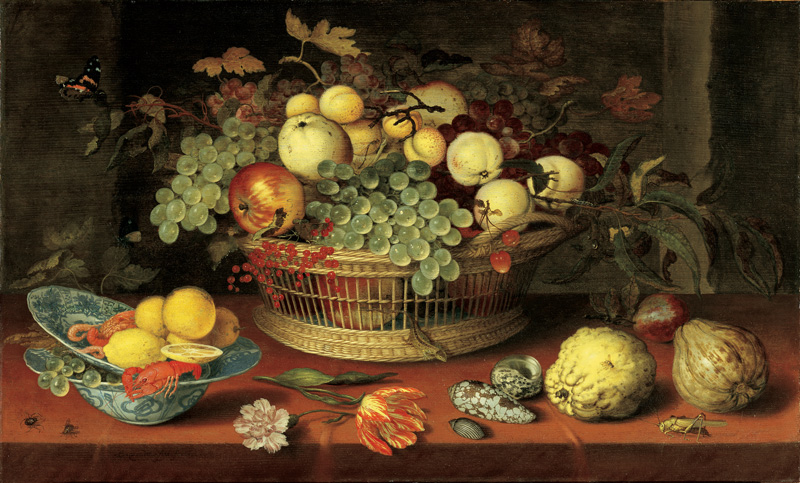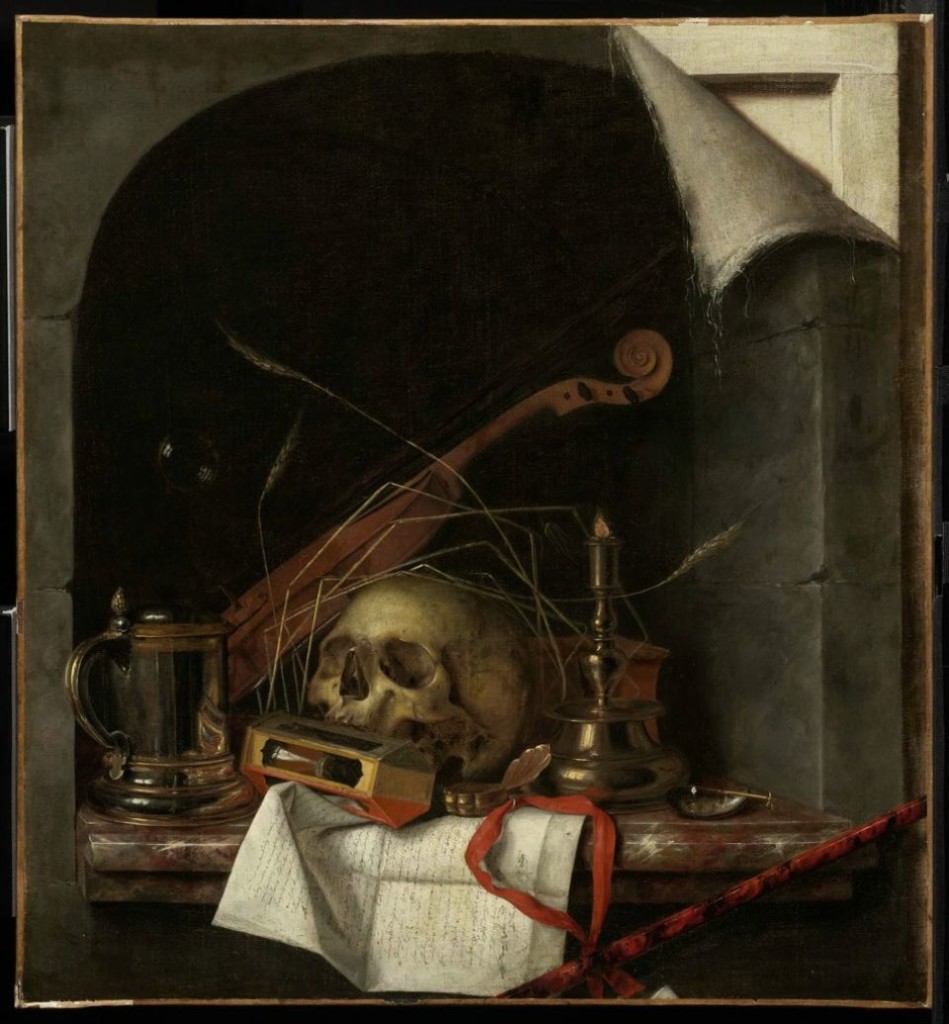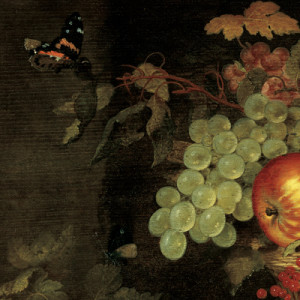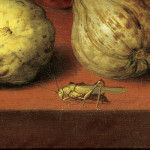
Still Life with Basket of Fruit
Balthasar van der Ast, Dutch, 1622
(oil on panel)
North Carolina Museum of Art, Raleigh
Let’s continue our discussion on the history of still life and look at two vanitas still life paintings that are rich in symbolism.
During the Age of Exploration, which began in the early 15th century, Europeans explored Africa, the Americas, Asia and Oceania. New discoveries in these lands led to a keen interest in the natural world. Wealthy Europeans would collect insects, shells, and exotic fruits and flowers and display them in “curio cabinets.” New plants such as the tulip, imported to Europe from Turkey, became vastly popular. Artists studied the physical qualities of these animal and mineral and vegetal specimens and painted them in a realistic manner in works without figures. These independent still life works, however, were more than documents of the natural world. Such vanitas works, as they are called, contained messages. Do you know what the word “vanitas” means? The Latin word “vanitas” simply means “vanity” and loosely corresponds to the meaninglessness of earthly life and the transient nature of all earthly goods and pursuits.
What kind of messages did these vanitas works contain? The fruit and flowers and other objects in vanitas works were there to remind viewers of the transience of life, that the beauty of the world was merely surface and what mattered most was what was behind this surface—namely, God. After all, time marches forward. Fruit rot. Flowers wilt. Life ends. Similar to the message in Aertsen’s Meat Stall, vanitas works instructed viewers to look beyond the short-lived physical world and prepare for the afterlife and the promise of immortality. They also were a reminder to do good works on earth so that the impact of one’s life would endure. Today we look at vanitas still life works and simply see the beauty and abundance of the natural world, but for the culture of the time these objects were more than beautiful to look at. They were loaded with symbolism.
Let’s take a close look at Still Life with Basket of Fruit. It portrays both man-made and natural objects that look completely real. Describe these objects. In the center, atop a burnt-orange tablecloth that covers a plank tabletop, there is a wicker basket filled with fruit, including grapes, apples, peaches, apricots, cherries and currants. If you look carefully, you can see a butterfly on the leaves of a grapevine tendril in the back of the basket. What other creatures can you see? There is a lizard crawling toward the base of the basket and a nearly invisible dragonfly with gossamer wings above the bunch of green grapes in the center.
In the foreground on the left (the space up front), a blue and white porcelain plate (perhaps antique Chinese) rests on top of a similar style bowl. Within these dishes there are lemons and a lemon slice, green grapes, two crayfish, and two shrimp. In the center foreground there is a cut carnation and a multicolored tulip. The blooms of the flowers extend beyond the edge of the tabletop, which help to create depth and give the illusion of three-dimensional space. On the right hand side there are more pieces of fruit, including a quince, a gourd, and perhaps a plum or pear. In between the flowers and these pieces of fruit there are three exotic shells—one from Africa, one from the East Indies, and one from the West Indies. Can you see any other creatures in the painting? There are two flies on the far left corner and a grasshopper on the far right corner.
For the viewers of the time, the fruit and flowers and animals would have reminded them of vanitas themes. For example, the fruit and flowers would have reminded them of the fragility of nature, the butterfly and grasshopper would have reminded them of decay and death, while the dragonfly would have reminded them that nature quickly fades. Viewers would have looked at this painting and would have been reminded that the beauty of the world was a kind of trickery and what mattered most was the immortal life to come. Viewers would also have seen the work as a warning against the vanity of spending vast sums of money on collections of rare bulbs and shells, which at the time was all the rage. Lastly, the work would have reminded viewers of the four elements—fruit with the earth, shells with water, flowers with air, and porcelain with fire.
Let’s study another vanitas still life painting. This time the objects are so real, they fool the eye completely! Indeed, the style is called trompe l’oil or “fool the eye.”

Vanitas Still Life
Cornelis Norbertus Gijsbrechts, Flemish, circa 1659-1675
(oil on canvas)
Museum of Fine Arts, Boston
The still life objects in this vanitas painting are loaded with symbolism. Let’s describe the many objects and determine their hidden meanings. There is a shelf in a darkened niche containing a skull. What do you think the skull symbolizes? The skull symbolizes that even human intellect can not overcome death. What else do you see? There is an hourglass turned on its side in front of the skull. What does the hourglass symbolize? The hourglass reminds us that our time on earth is brief. Surrounding the skull is cracked wheat, which is a reference to God and the Resurrection. There is a opened watch next to the hourglass, which symbolizes the passage of time. To the right of the skull there is a candle in a brass candlestick that is burning low and will eventually burn out. There is a violin (music) behind the skull, an oyster shell (food) to the right of the candlestick, and metal tankard (drink) to the left of the hourglass, each one symbolizing the transitory nature of the pleasures of life. Perhaps Gijsbrechts is telling the viewer that it is foolish to care only for the body without regard for the eternal rewards to come.
Look closely. What else do you see? What is floating above the tankard on the left? There is a crystalline bubble. What do you think the bubble symbolizes? Since a bubble bursts easily, it symbolizes the fragile nature of the material world. On the right hand corner, there is a red maulstick, which helps create depth backward into the picture plane. Do you know what a maulstick is? A maulstick is a device used by painters to hold one’s arm off a painting while working. Crumbled and hanging over the edge of the niche in front of the skull are sheets of paper with writing, which is in fact the calling card of the artist. It is a note that bears the address of the artist himself. What effect is the most hyper-realistic of all? Look at the upper right hand corner. The entire scene is shown to be a painted canvas that is being pulled from its stretcher! We are reminded that even though what we are looking at seems to be real, it is in fact an illusion, something created by an artist, bits of paint on canvas. We are also reminded that the real canvas in front of us will eventually pull apart too.
It is important to realize that paintings by Van der Ast and Gijsbrechts were more than cautionary tales. They were a form of entertainment, painted to delight and entertain with extravagant effects, similar to you and me watching a film with realistic special effects today!
For those of you who are interested, be sure to read our third and final entry on the history of still life. There we will look at examples of modern and contemporary still life.
§
Would you like to see Van der Ast’s Still Life in person? All you have to do is visit the North Carolina Museum of Art in Raleigh, North Carolina. Van der Ast’s Still Life is in the European galleries at the museum. Would you like to see Gijsbrechts’ Vanitas Still Life? All you have to do is visit the Museum of Fine Arts in Boston, Massachusetts. If you are interested in having a tour at either the North Carolina Museum of Art or the Museum of Fine Arts, check on-line or call ahead to find out the days and times tours are given to the public. Or perhaps you can contact either of these museums ahead of time and arrange for you and your friends to have a private tour. I’m sure a docent at either the North Carolina Museum of Art in Raleigh or the Museum of Fine Arts in Boston would be happy to show you and your friends the many wonderful works of art. Whether you visit these museums on your own or have a tour with a docent, it will be well worth your time!

